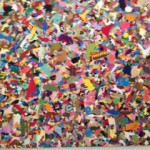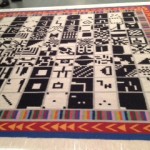Bringing the world into the world; giving time to time: the arresting phrases belong to Alighero Boetti, subject of a new show at MoMA. He died at 54 and so we’ll never know where his art would have gone over time. [It was a brain tumor… so sad.] But what I saw in NY confirmed my sense of what I had seen earlier that he was a talented thinker.
It’s conceptual art but also has the obsessive edge I value. Again and again, he plays with words reproduced and arranged at random but with a symmetry that brings order out of chaos or, better yet, plays order against chaos, relishing the tense effect. Again and again, he finds art where others would not: in the arrangement of stamps; in graph paper lines reproduced by hand where the errata make their mark; in maps coded by color and national flags in works that are tapestries rather than painting to sculpture.
It’s the genre crossing I like here: the maps, and (below) woven work, some done during a decade of visiting Afghanistan. Those carpets must have taken a lot of time and they reproduce bar codes and iPhone scanning. Those multicolored paintings are really woven fabrics, cut out and assembled collage style. The found object: the world. The arrangement: the world. All performed, over time.

















